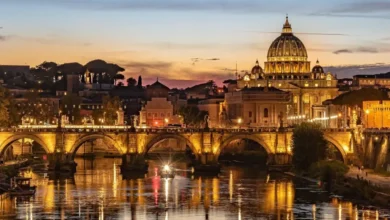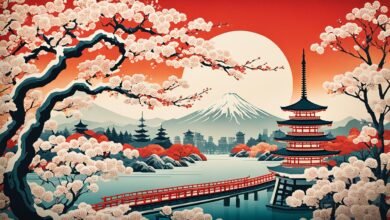Did you know that the Terracotta Army consists of over 8,000 ancient Chinese sculptures?
Near Xi'an, this massive clay soldier army was made under Qin Shi Huang. This emperor was China's first. The site is on UNESCO's World Heritage list. It shows both the burial traditions and the historical greatness of ancient China.
Let's explore the Terracotta Army's hidden stories. We'll look into its creation, the vast size of the site, the craftsmanship, ongoing studies, and its lasting impact on culture.
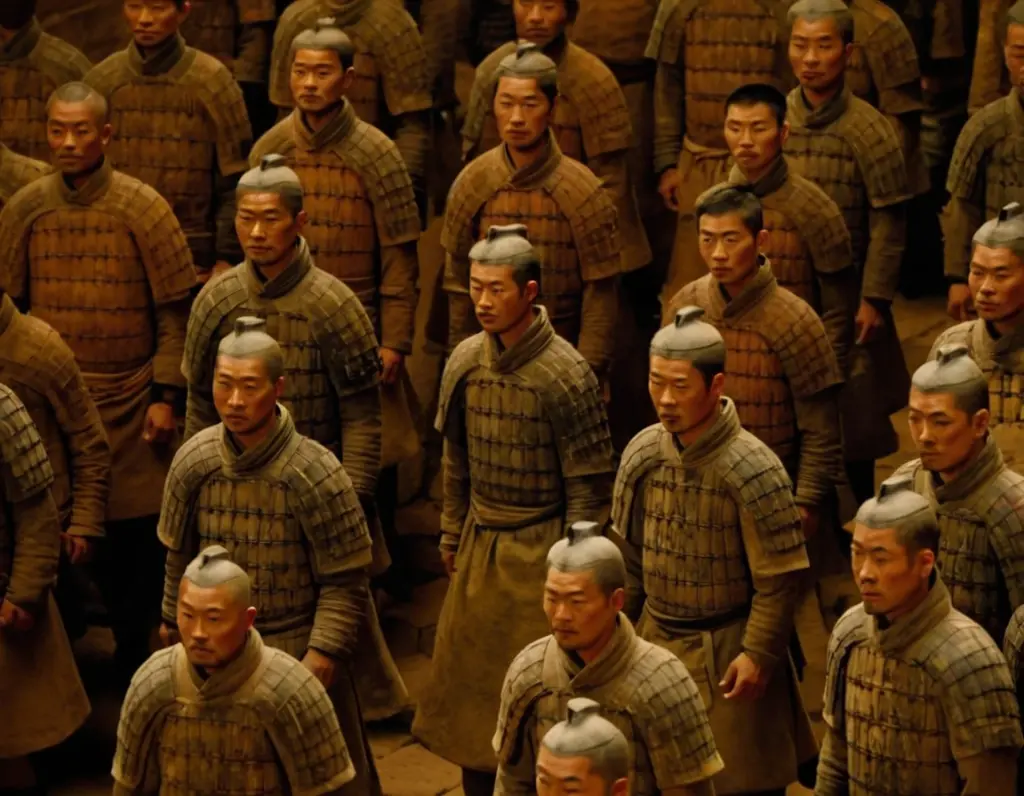
Unearthing History: The Story Behind the Terracotta Army
Qin Shi Huang was the first emperor of the Qin Dynasty. He unified China and set up a strong government. He also built the Great Wall of China, which is famous worldwide.
His biggest legacy might be the Terracotta Army. It was made for his tomb. This site is still a mystery today.
The Unification of China
Qin Shi Huang changed Chinese history. He created a single government and uniform laws. He also worked to make the culture the same across China. These changes affected everything from politics to education.
“Qin Shi Huang's ambition to create a unified China is reflected not only in the Terracotta Army but also in the construction of the Great Wall of China.”
The Mausoleum of the First Qin Emperor
The mausoleum shows Qin Shi Huang's greatness. Though it's mostly unexplored, it includes a vast palace underground. The Terracotta Army is there to protect the emperor in the afterlife.
“The Terracotta Army is not only a remarkable artistic creation but also a reflection of the emperor's desire for eternal protection and divine status.”
This hidden city holds many ancient secrets. It can teach us a lot about old Chinese funeral customs and beliefs.
The Ancient Soldiers Frozen in Time
The Terracotta Army has thousands of sculptures. They show soldiers, horses, and chariots in detail. Each statue is unique, showing different military ranks and roles.
Each figure shows the face and armor of a soldier. This army was meant to keep the emperor safe after death. It also shows the emperor's wish to live forever.
“The Terracotta Army encapsulates the military prowess and organizational skills of ancient China, underscoring the influence and significance of the Qin Dynasty.”
| Qin Shi Huang's Achievements | |
|---|---|
| Centralized imperial rule | Unification of China |
| Military advancements | Creation of the Terracotta Army |
| Infrastructure development | Construction of the Great Wall of China |
The Astonishing Scale of the Terracotta Army
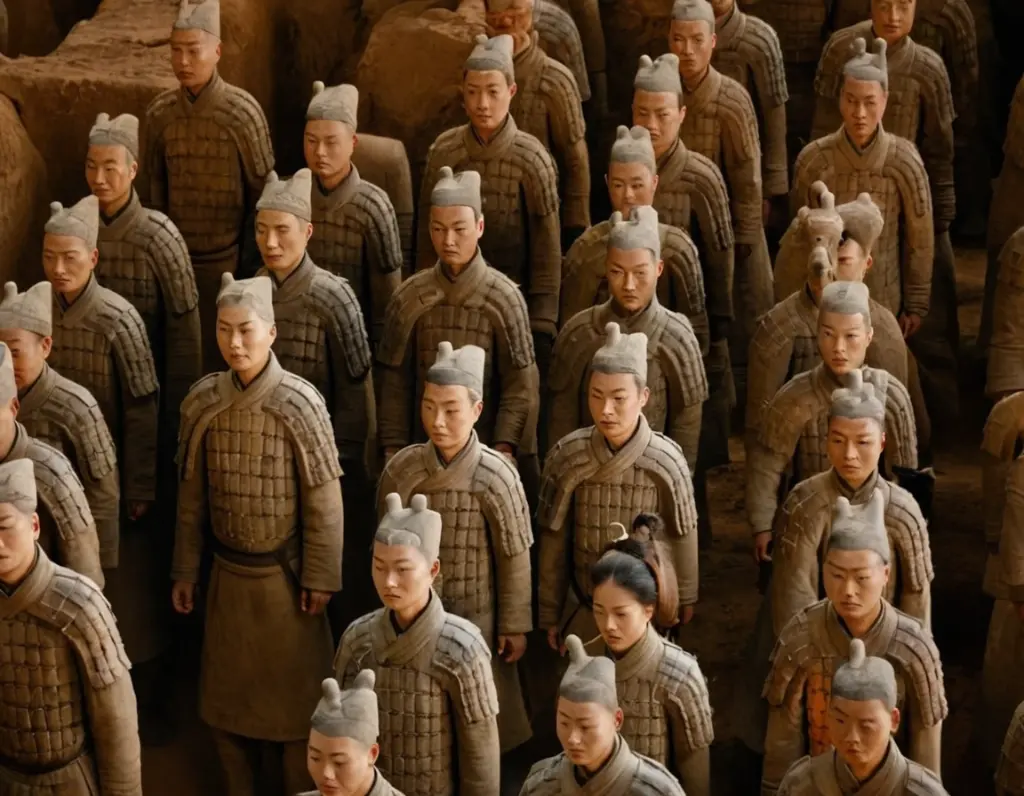
The Terracotta Army is in Xi'an, Shaanxi province, China. It shows the massive scale of this archaeological site. The area spans over 22 square miles and has more than 600 pits. These pits are full of amazing sculptures. They include clay soldiers, horses, and chariots. People around the world find them fascinating because of their historical importance.
The site's main feature is the Mausoleum of the First Qin Emperor. Here, the sculptures were first found. To let visitors see them, the Museum of Qin Terra-Cotta Warriors and Horses was set up. It has three major pits. These pits display the extraordinary skill used to create these ancient artifacts.
Through careful digging and preservation, we've learned about ancient China's life and military. The Terracotta Army's size shows the First Emperor of China, Qin Shi Huang's ambition and power. He wanted this eternal army to be with him after death.
The Museum of Qin Terra-Cotta Warriors and Horses
The Museum of Qin Terra-Cotta Warriors and Horses focuses on preserving and showing the Terracotta Army. It is famous worldwide. It holds the most crucial findings from the site.
In the museum, visitors can see the sculptures' fine details. They learn about ancient China's military and artistic skills. The three main pits offer a look at the ancient army's size and splendor.
The museum displays life-sized infantrymen, archers, chariots, and high-ranking officers. Each is made with unique features and expressions. Walking through the museum, you'll be struck by the Terracotta Army's size and artistry.
| Museum Features | Highlights |
|---|---|
| 1. Pit 1: The largest and most impressive pit, featuring rows of infantrymen and chariots. | • Life-sized sculptures • Intricate details |
| 2. Pit 2: Showcasing a mix of archers, infantrymen, and cavalry units. | • Diverse array of soldiers • High-ranking officers |
| 3. Pit 3: Emphasizing the command structure with generals and other ranking officers. | • Command structure showcased • Unique uniforms and features |
A Glimpse into Ancient Funerary Art
Funerary art honors the dead and preserves their memory. It connects the living with those who have passed. A prime example is China's Terracotta Army, made to honor the First Emperor of China, Qin Shi Huang.
This collection, found in the First Qin Emperor's Mausoleum, shows deep respect for the deceased in ancient China. Crafted with care, the soldiers, horses, and chariots were all meant to follow the emperor after death. Each statue is unique, giving them a touch of personality and ensuring the emperor is always remembered.
The artistry behind the Terracotta Army showcases ancient Chinese talent. The soldiers' detailed features reflect the sculptors' skill and the cultural ideals of the Qin Dynasty.
The Terracotta Army stands as a testament to the cultural significance of funerary art, serving as a bridge between the past and the present. It offers a glimpse into the rich history and deep-rooted traditions of ancient China.
This breathtaking funerary art has fascinated people worldwide. It draws them into ancient China's mysteries and helps them appreciate its cultural depth and historical importance.
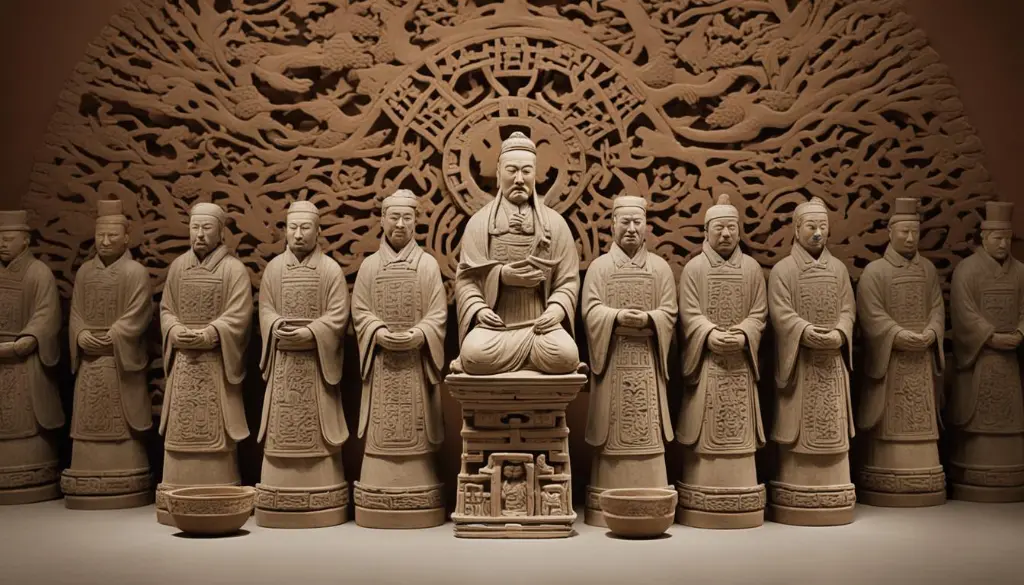
Crafting the Immortal Soldiers: Techniques and Materials
The Terracotta Army, a marvel of ancient China, was crafted with great skill. Let's explore the artisan techniques and materials used for these clay sculptures.
Hand-Sculpting and Assembly Line Techniques
The artisans used hand-sculpting and assembly line techniques. They shaped clay into detailed forms by hand, making each soldier unique. The assembly line helped create thousands of soldiers quickly.
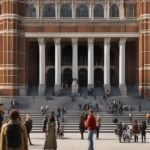 Explore Art & History at the Rijksmuseum Now
Explore Art & History at the Rijksmuseum Now
Vibrant Colors and Realistic Details
Originally, the sculptures were painted in bright colors. They used mineral and plant pigments for these colors.
“The vivid colors of the Terracotta Army were a testament to ancient China's pigmentation techniques, bringing unparalleled vibrancy to the sculptures.” – Renowned art historian
The Terracotta Army's sculptures were also very detailed. Each soldier's face, armor, and weapons were made with great care. This showed the advanced military technology of ancient China.
Weapons and Armor Reflecting Ancient Military Technology
The sculptures had many types of weapons and armor, showing the Qin Dynasty's military strength. There were infantrymen with swords and archers with bows. This variety showed different military roles' importance.
Illustration presenting various weapons and armor found in the Terracotta Army.
These carefully made weapons and armor show us ancient China's military technology. They reveal the Qin Dynasty's strategic and defensive abilities.
The Terracotta Army, with its skilled artistry, vibrant colors, and accurate military gear, highlights ancient China's creativity and artistic talent.
The Discovery and Significance of the Terracotta Army
In 1974, local farmers digging a well near Xi'an, China, made an incredible find. They uncovered the Terracotta Army, one of the most stunning discoveries in human history.
This army is part of Qin Shi Huang's mausoleum, China's first emperor. He ruled in the Qin Dynasty from 221-206 BCE. The mausoleum is like a giant underground palace that we've barely seen.
The army found near the emperor's tomb includes thousands of clay figures. There are soldiers, horses, and even generals, all life-sized. The detail on each figure shows the power of ancient China's military.
Our understanding of ancient China grows as researchers study this site. They reveal new things about its culture, society, and military ways.
Research on the Terracotta Army has taught us a lot about how it was made. It also shows more about the time of Qin Shi Huang. This site keeps teaching us about ancient China.
Thanks to the Terracotta Army, we know much more about ancient Chinese history. This find shows the artistic skill and achievements of ancient China. It's a key part of China's cultural past.
Remarkable Exhibitions and Global Appeal
The Terracotta Army has caught the eye of people everywhere with its history and art. Museums around the globe have displayed these original sculptures, making them famous worldwide. The British Museum, the Metropolitan Museum of Art, and the National Geographic Society Museum have all hosted these unique showcases.
“The Terracotta Army represents an extraordinary testament to ancient China's rich cultural heritage. Its global appeal stems from its awe-inspiring scale and historical importance, attracting enthusiasts and scholars alike.”
Exhibitions of the Terracotta Army let everyone explore ancient China's captivating history. These events show off the skilled craftsmanship and unmatched artistry of the clay soldiers. They also highlight their cultural importance.
By presenting the Terracotta Army at global museums, these exhibitions promote ancient history and cultural sharing. They encourage discussions and help people understand different cultures better. Through these events, people learn about the Qin Dynasty and its influence on China's military, society, and culture.
The Terracotta Army's exhibitions illustrate the lasting appeal of these artifacts. They show art and history's role in connecting cultures.
Museums Hosting Terracotta Army Exhibitions
| Museum | Location |
|---|---|
| British Museum | London, United Kingdom |
| Metropolitan Museum of Art | New York City, USA |
| National Geographic Society Museum | Washington D.C., USA |
These exhibitions do more than just display the Terracotta Army's impressive sculptures. They also play a crucial role in protecting cultural heritage. By showcasing these ancient artifacts, they ensure the legacy of the clay soldiers continues. This connects the past and present for future generations.

Insights from Ongoing Research and New Discoveries
Research on the Terracotta Army brings new, fascinating findings. Experts use advanced tech to study its construction and history. They explore the complex process of making these amazing sculptures.
Advanced imaging helps uncover hidden statue details. High-res scans and 3D models show each sculpture's unique craftsmanship. This gives us a closer look at the artists' skills.
The composition of the statues is studied through chemical analysis. It shows which clays were used and their properties. This tells us about the materials available back then and ancient crafting methods.
“The combination of advanced imaging techniques and chemical analysis allows us to peer into the past and gain insights into the complexity of creating these magnificent sculptures. It is through this interdisciplinary approach that we can unlock the secrets of the supply chain and manufacturing process.” – Dr. Li Mei, Archaeologist
Recent studies on the Terracotta Army bring to light new facts. Chromium found on weapons shows the ancient Chinese knew advanced metal work. The study of clay tells us they used a clever system for choosing and getting their materials.
The more we learn from ongoing research, the more fascinated we become with the Terracotta Army. Each new discovery deepens our appreciation of this ancient wonder. It confirms its importance among the great historical treasures of the world.
| Research Findings | Advanced Imaging Techniques | Chemical Analysis | Supply Chain and Manufacturing Process |
|---|---|---|---|
| Identification of hidden details and features | A deeper understanding of artistry | Information on raw materials and manufacturing techniques | Insights into clay selection and supply |
| Presence of chromium on weapons |
The Legacy and Cultural Significance of the Terracotta Warriors
The Terracotta Army's lasting legacy shines as a beacon of China's cultural heritage. It represents ancient China's achievements and traditions. This grand display bonds us with the past.
 Explore Secrets of Art at Vatican Museums
Explore Secrets of Art at Vatican Museums
Efforts to keep the site for future generations are happening now. These efforts aim to maintain the sculptures and the site's integrity. This way, we ensure they last for many years.
The Terracotta Army guards ancient Chinese history and knowledge. It offers a window into past society, military, and art. These insights are priceless.
“The Terracotta Army is not just a collection of sculptures; it represents the cultural and historical essence of ancient China. It holds the voices and stories of countless individuals who contributed to the greatness of the Qin Dynasty.” – Dr. Liu Xinyuan, leading archaeologist.
This army captivates people from every corner of the globe. It invites us to explore ancient China's mysteries. Its impact stretches beyond simple existence, sparking curiosity and wonder in everyone.
Preservation Efforts and Cultural Appreciation
The Chinese government and global groups work together to protect this legacy. They use modern methods and teamwork to keep these treasures safe. This includes educational activities, museum displays, and various events to celebrate this cultural jewel.
Standing before these historic warriors, visitors dive into ancient China's spirit. This site proves the Terracotta Army's timeless influence and how it enriches our grasp of history.
| Legacy | Cultural Heritage | Preservation | Historical Importance |
|---|---|---|---|
| Symbol of China's rich history | Offers insights into ancient Chinese culture | Ongoing efforts to protect and preserve | Contributes to the understanding of ancient China |
| Reminder of remarkable achievements | Provides educational and cultural experiences | Promotes research and conservation | Preserves historical artifacts |
| Deep-rooted cultural traditions | Engages domestic and international visitors | Includes advanced conservation techniques | Highlights the significance of the Qin Dynasty |
The Terracotta Army: A Window into Ancient China’s Military Might
The Terracotta Army is fascinating. It shows the military setup of ancient China vividly. With detailed sculptures, it reveals the Qin Dynasty's military strength. As you look around, you'll see soldiers of all ranks. This includes infantry, archers, cavalry, and top officers. Each figure highlights the care and uniqueness in ancient China's military.
“The Terracotta Army is a remarkable example of the military might that existed during the Qin Dynasty. The sculptures provide valuable insights into the power and organization of ancient China's military forces.” – Renowned historian
As you walk among the figures, you'll notice different military roles. The infantrymen are posed to show their discipline. Archers are ready to demonstrate their aim. The cavalry sits on impressive horses, showing off ancient China's fast warriors.
The officers stand out for their commanding presence. They symbolize leadership and smart planning.
The Terracotta Army's preservation helps us learn ancient military tactics and strategies. From careful formations to weapon expertise, every figure tells a piece of ancient military history. The collaboration among the soldiers highlights the teamwork needed for successful battles.
Archers and their Significant Role
The archers in the Terracotta Army are especially important. Their mastery in archery was vital in ancient warfare. The sculptures show their focus and the high value placed on them in battle.
Archers were key not just in combat, but for support too. With their precise shots, they could hit critical targets, break enemy lines, and cause chaos from afar. Their quick moves and sharpshooting were assets in the Qin Dynasty's military endeavors.
| Rank | Description |
|---|---|
| Infantrymen | Formed the backbone of the army, displayed discipline and strength on the battlefield. |
| Archers | Mastered the bow and arrow, provided long-range support and disrupted enemy formations. |
| Cavalry | Mounted warriors, showcased mobility and speed, ideal for flanking maneuvers. |
| High-Ranking Officers | Commanded forces, strategized military campaigns, and exemplified leadership. |
The depiction of archers in the Terracotta Army highlights their key role in the military. Marveling at these sculptures, you'll appreciate the craftsmanship and organization that set ancient China's military apart.
Unveiling the Secrets of Qin Shi Huang’s Silent Warriors

The Terracotta Army gives us a peek into ancient China's society during the Qin Dynasty. These sculptures show us the culture, beliefs, and military ways of that time. This helps us learn more about Qin Shi Huang's silent warriors and ancient China.
Under Qin Shi Huang, the first emperor, China became one unified empire. His legacy includes the Great Wall and the Terracotta Army. These works changed Chinese history.
“The past informs the present, and we owe our current understanding of ancient China's society and culture to the remarkable discoveries unearthed at the Terracotta Army site,” says Dr. Li Wei, a renowned archaeologist specializing in ancient Chinese history.
The First Qin Emperor's mausoleum tells us about life in the Qin Dynasty. The terracotta sculptures reveal military rankings and the skills of ancient Chinese artists. They show the era's hierarchy, military setup, and craftsmanship.
Studies at the Terracotta Army site are uncovering more about Qin Shi Huang's era. Techniques like imaging and chemical testing help researchers. They're learning how the warriors were made and what materials were used.
“By studying the Terracotta Army, we gain a deeper appreciation for the historical and cultural context of ancient China and how it shaped the society we know today,” says Professor Zhang Jing, a history expert at Beijing University.
The work at the Terracotta Army site is making us smarter about ancient China. It's like putting together puzzle pieces from the past. This lets us see the full picture of ancient China's culture and military strength during the Qin Dynasty.
Exploring Ancient China’s Society and Culture
The Terracotta Army shows the diverse social ranks of ancient China's military. It includes figures from normal soldiers to top generals. These detailed figures help us understand the military's role back then.
This Army also shares the cultural and spiritual beliefs of that era. Figures of horses and chariots suggest beliefs in life after death. They thought these items were needed for the emperor's next life.
Creating the Terracotta Army was an act of respect for the emperor. It shows the care for the afterlife and the impact of the elite on society. This reflects ancient China's cultural values and practices.
The Enduring Fascination with the Terracotta Army
The Terracotta Army is an amazing piece of history showing ancient China's art and culture. It captures the attention of people worldwide.
This incredible collection draws visitors from all over. It lets you dive deep into the ancient civilization's history and culture. You learn and appreciate more about it.
 Visit Acropolis Museum – Unveil Ancient Wonders
Visit Acropolis Museum – Unveil Ancient Wonders
The Terracotta Army is more than just a sight to see. It holds deep meaning for many, encouraging us to explore and admire. This stunning work of art raises curiosity about ancient China's society, skills, and military strength.
